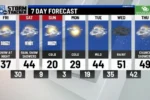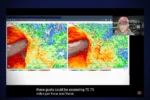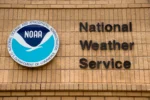Have you ever wondered what happens when bad weather hits your town? In Charlottesville, Virginia, the local bus service called CAT had to make a tough decision on February 11. Even though their buses were running for most of the day, they had to stop around 3 p.m. because the weather was getting worse. Safety is super important for CAT, and they want to keep everyone safe while helping people get where they need to go. Let’s explore why the CAT bus service is so important and how they handle challenges like bad weather!
| Date | Service Status | Reason for Suspension | Time Services Ceased | Safety Statement |
|---|---|---|---|---|
| February 11 | Suspended | Inclement Weather | 3 p.m. (Micro-Cat at 1 p.m.) | Safety is the top priority. |
Understanding the Suspension of Bus Services
Bus services in Charlottesville were temporarily halted due to bad weather conditions on February 11. The Charlottesville Area Transit (CAT) buses ran for most of the day but had to stop operations around 3 p.m. This decision was made to ensure the safety of passengers and drivers alike. During such weather events, it’s crucial for transit services to prioritize safety over convenience.
The Micro-Cat service closed even earlier, at 1 p.m., showing how quickly the weather can change and impact public transportation. CAT’s team works hard to monitor conditions and keep services running as long as it is safe. Understanding these decisions helps riders know that safety is always the main focus, even if it means suspending bus operations.
Safety First: Importance of Weather-Related Decisions
When bad weather strikes, safety becomes the number one concern for bus services like CAT. During storms or heavy rain, roads can become dangerous, making it hard for buses to operate safely. CAT’s marketing coordinator, Alex Pasqualone, emphasized that many people depend on these services. They strive to keep buses running as long as it is safe to do so, showing their commitment to the community.
These weather-related decisions are not taken lightly. The CAT team constantly evaluates road conditions and weather forecasts to ensure everyone stays safe. By halting services when necessary, they help prevent accidents and ensure that both passengers and drivers are protected during inclement weather. Safety truly comes first in these situations.
Staying Informed About Bus Services
For riders who rely on CAT services, staying informed is essential, especially during bad weather. The CAT agency provides updates on bus routes and schedules, helping people plan their travel accordingly. When services are suspended, it is important for passengers to know how to find this information quickly.
Riders can check CAT’s website or social media for the latest updates on service changes. By staying connected, passengers can ensure they are aware of any disruptions and can make alternative arrangements if needed. Being informed helps everyone travel safely and confidently, even when weather conditions are less than ideal.
Understanding the Impact of Weather on Public Transportation
Inclement weather can significantly disrupt public transportation services, affecting both operations and commuter schedules. For agencies like Charlottesville Area Transit (CAT), the decision to suspend bus services is often driven by safety concerns for both passengers and drivers. When conditions such as heavy snow, ice, or severe storms arise, CAT must prioritize the well-being of the community, making timely adjustments to their service.
Moreover, the ripple effects of service suspension can be felt by many residents who depend on public transit for daily commutes. It is vital for transit authorities to communicate effectively about service changes, ensuring that passengers are informed and can plan accordingly. Understanding these impacts can help commuters develop alternative plans during adverse weather conditions, minimizing inconvenience.
Safety Protocols in Adverse Weather Conditions
Public transportation agencies like CAT implement a series of safety protocols during inclement weather to protect both passengers and staff. This includes closely monitoring weather forecasts and conducting assessments of road conditions to determine the feasibility of operations. Should conditions become unsafe, as was the case on February 11, agencies must act swiftly to suspend services, ensuring that drivers are not put at risk.
Additionally, CAT’s commitment to safety is reflected in their communication strategy. By informing the public about service changes and the reasons behind them, they foster trust and understanding within the community. Passengers are encouraged to stay updated through official channels, which can provide timely information about service resumption and alternate transportation options.
Community Reliance on Transit Services
Many residents in Charlottesville rely heavily on CAT for their daily transportation needs, highlighting the importance of maintaining bus services whenever possible. Public transit provides essential access to jobs, education, and healthcare, making it a vital resource for the community. When bus services are suspended, it can create challenges for those who depend on them to fulfill their daily obligations.
Recognizing this reliance, CAT strives to operate their services safely and efficiently, even in difficult weather conditions. The agency’s marketing coordinator emphasized that keeping services running for as long as possible is a priority, showcasing their dedication to serving the community. This commitment to service continuity reinforces the importance of public transit in enhancing the quality of life for residents.
How to Stay Informed During Service Interruptions
During service interruptions due to adverse weather, staying informed is crucial for commuters. CAT encourages passengers to utilize their official website and social media channels for real-time updates on service changes and safety announcements. By following these platforms, riders can receive timely information that helps them make informed decisions about their travel plans.
Additionally, CAT’s commitment to transparency ensures that passengers are aware of the reasons behind service suspensions. Keeping the lines of communication open not only reassures the community but also helps individuals explore alternative transportation options when necessary. Whether it’s carpooling, biking, or using rideshare services, being informed can minimize disruptions during inclement weather.
Frequently Asked Questions
Why did CAT stop bus services on February 11?
CAT stopped bus services because of **bad weather**. They want to keep everyone safe, so they halted operations when conditions got worse.
What is CAT and what do they do?
CAT stands for **Charlottesville Area Transit**. They provide bus services to help people travel around the city every day.
How does CAT decide when to close the bus services?
CAT decides to close services based on the **safety of drivers and passengers**. If the weather is too dangerous, they stop the buses to protect everyone.
What should I do if I need a bus during bad weather?
If you need a bus during bad weather, check the **CAT website** for updates. They provide information about any changes in services.
Why is safety important for bus services?
Safety is important for bus services to protect **drivers and passengers** from accidents. If conditions are unsafe, it’s better to stop the buses.
What time did Micro-Cat stop their services?
The Micro-Cat stopped its services at **1 p.m.** on February 11 because of the bad weather conditions.
How can I find updates about CAT bus routes?
You can find updates about CAT bus routes by visiting the **CAT website**. They post the latest news and schedule changes there.
Summary
The content discusses the suspension of Charlottesville Area Transit (CAT) bus services due to inclement weather, which began on February 11. Buses operated until approximately 3 p.m., while the Micro-Cat service ceased operations earlier at 1 p.m. CAT’s marketing coordinator emphasized that safety is the primary concern, and the agency strives to maintain service as long as conditions allow. The decision to halt operations reflects the agency’s commitment to ensuring the safety of drivers and passengers, acknowledging the reliance of many community members on CAT services. Overall, the content highlights the balance between operational service and safety in adverse conditions.







